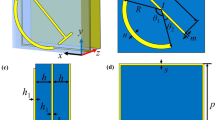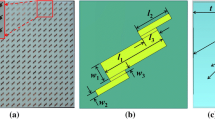Abstract
A broadband reflective polarization converter is proposed. The unit cell of polarization converter is composed of a single-split resonant ring, a double-split resonant ring, a dielectric substrate and a metallic ground. The simulated results show that the polarization converter can convert x-polarized waves into y-polarized waves and obtain a broadband polarization conversion from 0.501 0 THz to 1.390 0 THz with the polarization conversion ratio (PCR) beyond 80% at normal incidence. Moreover, the surface current distributions are investigated to explain the polarization conversion mechanism. Finally, a good agreement is achieved between simulated and measured results. The polarization converter can be applied in terahertz imaging, communication and stealthy technology.
Similar content being viewed by others
References
Li J, Zhang A, Joines W T and Liu QH, A miniaturized circularly polarized microstrip antenna with bandwidth enhancement, IEEE International Symposium on Antennas and Propagation, 41 (2016).
Ryzhkov A V, Giangrande S E, Melnikov V M and Schuur T J, Journal of Atmospheric & Oceanic Technology 22, 1138 (2004).
Maltsev A, Perahia E, Maslennikov R, Sevastyanov A, Lomayev A and Khoryaev A, IEEE Antennas & Wireless Propagation Letters 9, 413 (2010).
Meissner T and Wentz F J, IEEE Transactions on Geoscience & Remote Sensing 44, 506 (2006).
Bao Q, Zhang H, Wang B, Ni Z, Lim, C, Wang Y, Tang D and Loh K, Nature Photonics 5, 411 (2011).
Zheng J and Wen X, Optics Express 22, 28292 (2014).
Cheng Y Z, Withayachumnankul W, Upadhyay A, Hiadland D, Nie Y, Gong R, Bhaskaran M, Sriram S and Abbott D Applied Physics Letters 105, 26 (2014).
Chen H Y, Wang J F, Ma H, Qu S B, Zhang J Q, Xu Z and Zhang A X, Chinese Physics B 24, 253 (2015).
Liu Y, Xia S, Shi H, Zhang A and Xu Z, Applied Physics B 122, 178 (2016).
Li S J, Xu L M, Cao X Y, Han J, Zhang Z, Liu X, Feng K and Zhang C, Radio–engineering 25, 707 (2016).
Xu K K, Xiao Z Y and Tang J Y, Plasmonics 12, 1 (2016).
Zhou L, Zhao G Z and Li Y H, Laser & Optoelectronics Progress 55, 041602 (2018). (in Chinese)
Li Y H, Zhou L and Zhao G Z, Chinese Journal of Laser 45, 0314001 (2018). (in Chinese)
Fu Y N, Zhang X Q, Zhao G Z, Li Y H and Yu J Y, Acta Physica Sinica 66, 180701 (2017). (in Chinese)
Chen H T, Taylor A J and Yu N, Reports on Progress in Physics Physical Society 79, 076401 (2016).
Author information
Authors and Affiliations
Corresponding author
Additional information
This work has been supported by the New Direction Cultivation Project of Chongqing University of Posts and Telecommunications (No.A2014-116).
Rights and permissions
About this article
Cite this article
Pan, W., Shen, Dj. & Yan, Yj. Design of broadband polarization converter for terahertz waves. Optoelectron. Lett. 14, 434–437 (2018). https://doi.org/10.1007/s11801-018-8072-3
Received:
Revised:
Published:
Issue Date:
DOI: https://doi.org/10.1007/s11801-018-8072-3




